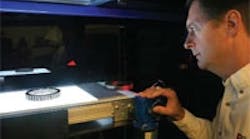Cincinnati Automation's automated inspection machines are now lighter on their feet than ever. That's because this custom machine integrator recently adopted a new LED backlit conveyor to convert automotive part gaging from a step-by-step process to a continuous method, more than tripling throughput. The AccuVision conveyor from Conveyor Technologies Ltd., Milford, Ohio, features a grid of high-intensity LED lights beaming up through a translucent urethane conveyor belt.
“For gaging operations, backlighting is positively preferred,” says Phillip Smith, Cincinnati Automation president. “You get a silhouette of the part with crisp edges, sharp contrast, and no shadows for precise dimensional inspection against the programmed master.”
In the past, the Erlanger, Ky., company would have processed the parts on a stationary backlight table. To gage overall geometry and edge geometry, the company used a pick-and-place system for part transfer and a walking beam to advance parts to the first station for top inspection, and on to the second station for side inspection. Pick-and-place backlit gaging was limited to about 10 parts per minute, compared to 36 a minute for the new continuous conveyor system. The higher processing speed is governed by the speed of the part loading system. Smith believes a backlit system could easily handle 60 to 120 parts per minute, depending on part size and faster loading capabilities.
The continuous gaging system is configured to run 40 different part numbers for the automotive supplier, ranging from 5 to 8 in. OD. Robot grippers load the parts three at a time on the 66 × 12 in. translucent belt. Parts advance along the belt to the LED light field, where an overhead digital camera with an 8.5 in. field of view visually gages each one. At the end of the conveyor, a second camera with a 0.5 in. field of view gages the side geometry, catching the lead edge just as it extends beyond the conveyor. Parts then pass off the conveyor to an incline slide with a diverter flap and failed parts drop through a slot in the incline. The flap lowers for good parts, covering the slot and allowing parts to pass down to the next station.
Integrating backlighting with the conveyor lead to a highly compact design, with the entire machine measuring just 96 × 36 × 70 in. The bed of the conveyor is only 2.28 in. deep, even with the LED light module mounted inside. Made of translucent urethane, the conveyor belt has high-quality diffusion properties and a superior, even light for the camera, according to Smith. For more information, visit www.cincinnatiautomation.com or www.conveyortechltd.com.
